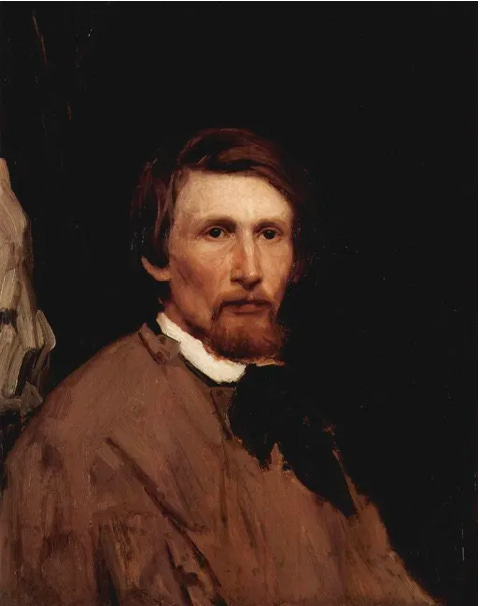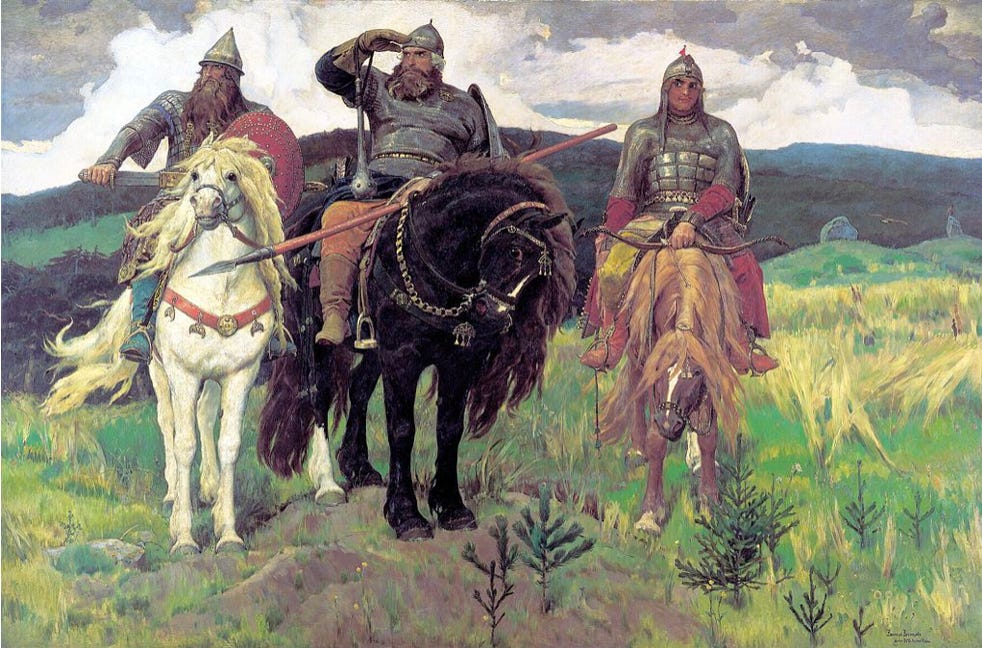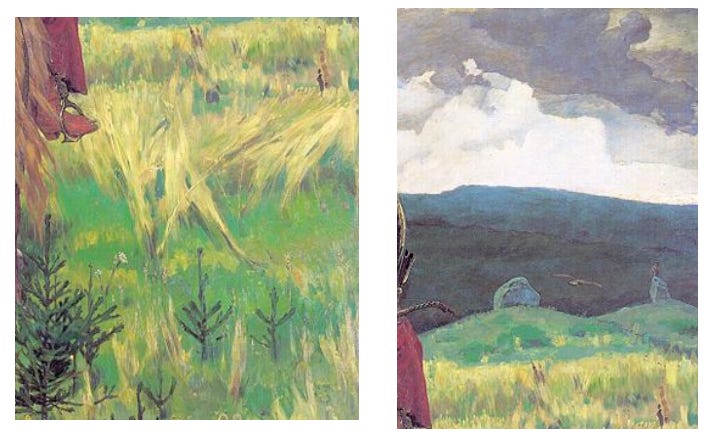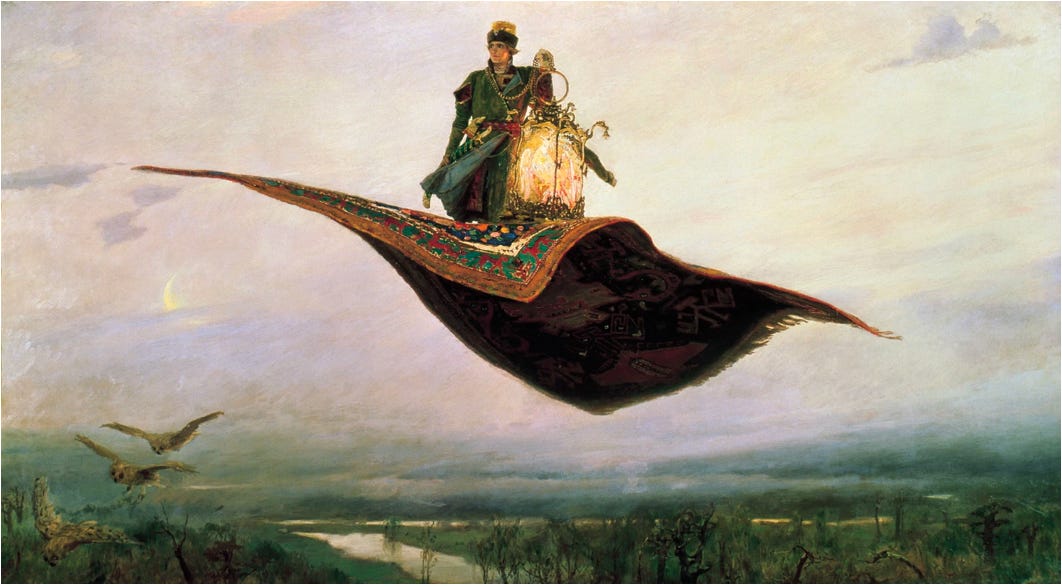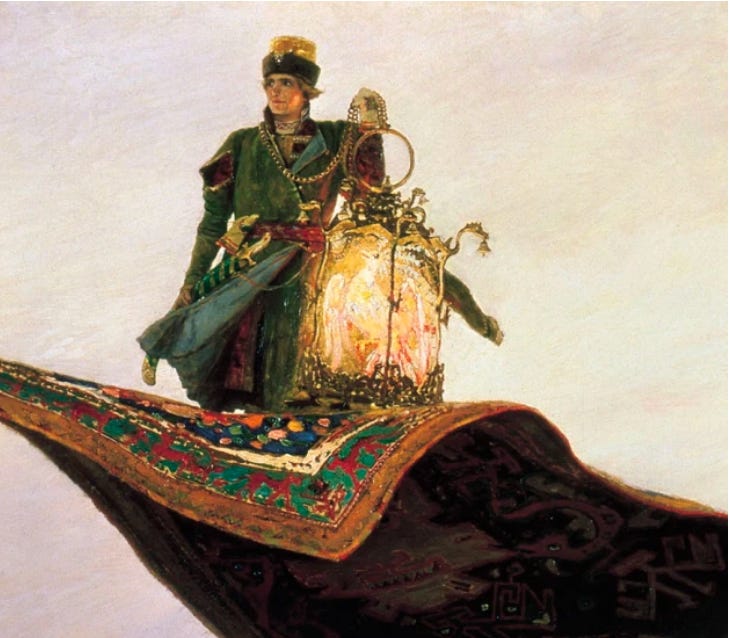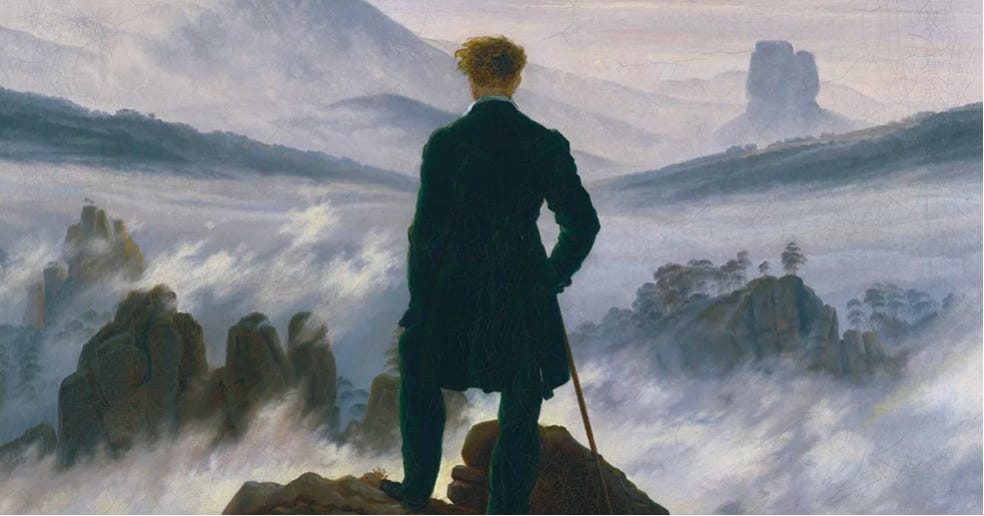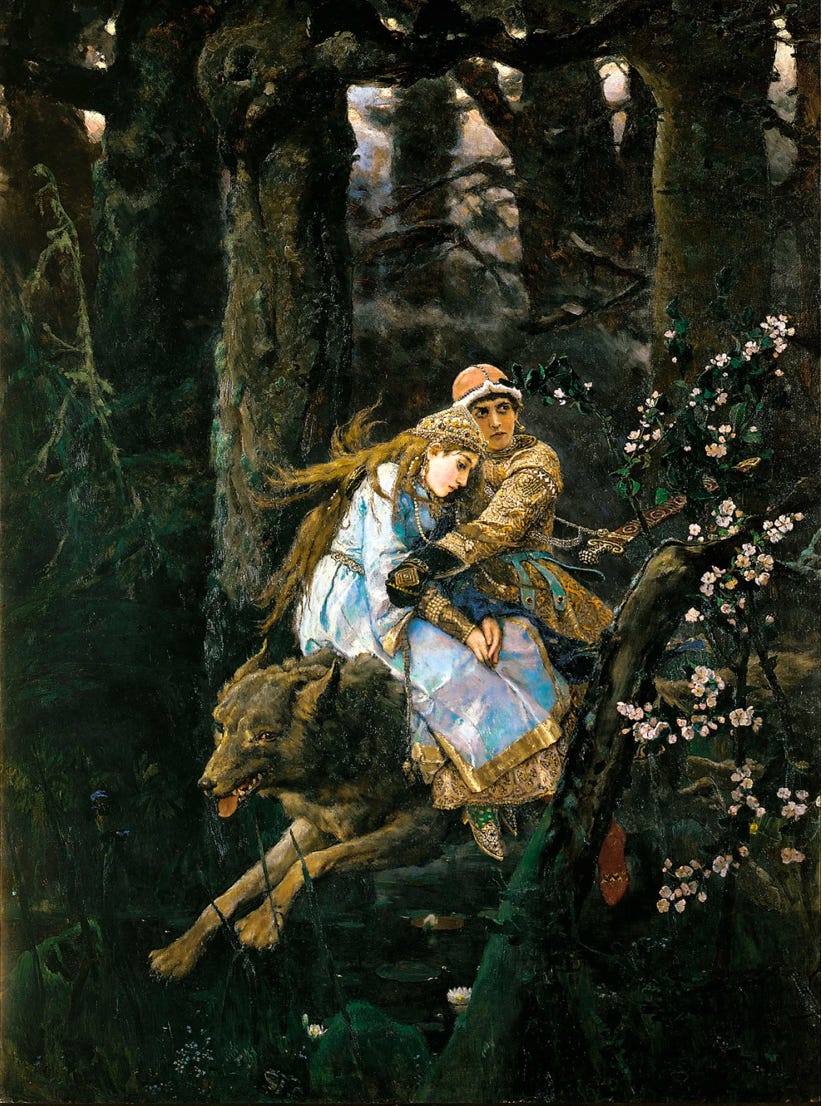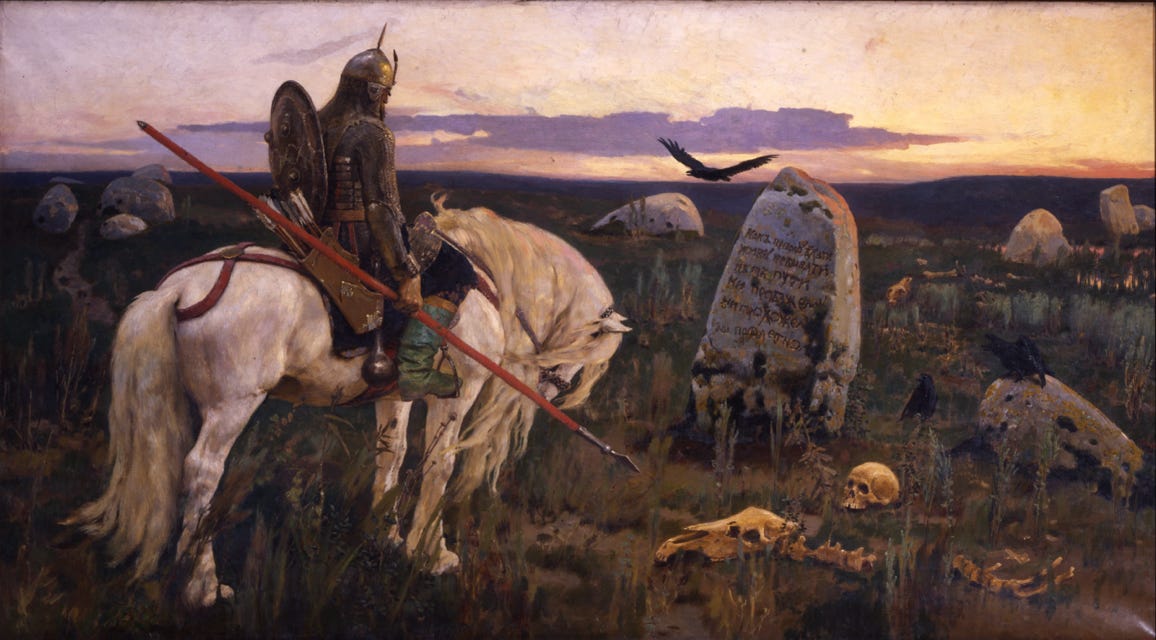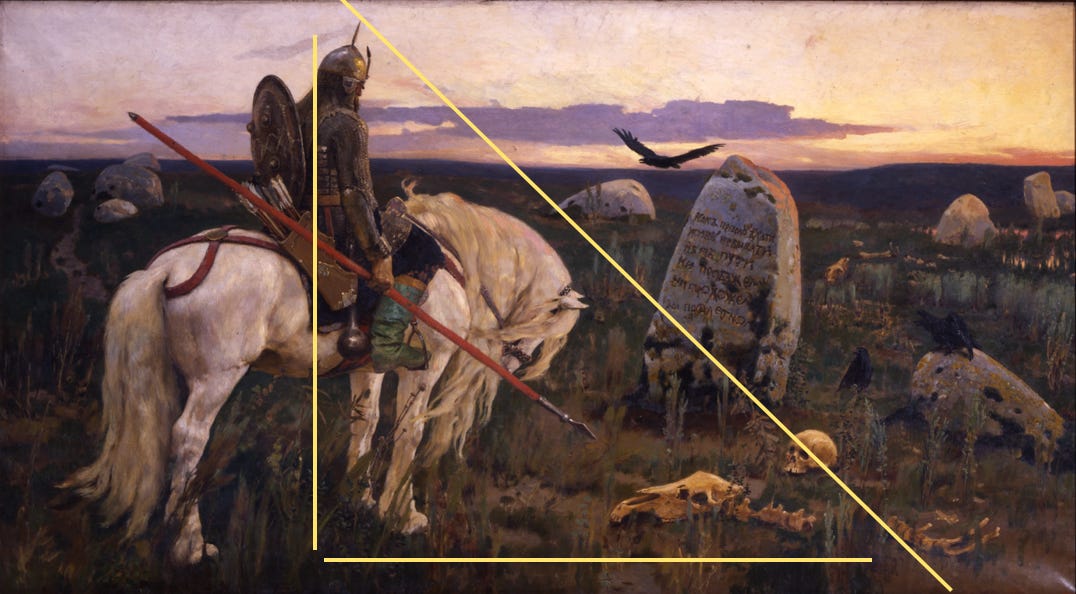Dear readers, I am starting a new series on my blog covering a wide range of fine artists that I adore and explaining some of their best artwork. I will make the first episode in this series free for everyone! Regular articles will continue as scheduled on Thursdays :)
“In fairy tales, songs, bylinas, and other affects, the entire face of the whole people, internal and external with past and present, as can be, and as the future, is shown” - Viktor Vasnetsov
The depiction of fairy tales in art is one of the most challenging yet important functions of fine art, for unlike other art, the land and inhabitants of the fairy tale are not set in stone nor can they find reference in our “real world”. A child first encounters fine art in his fairy tale books narrated by a parent’s voice at the tenderest and most impressionable stage of life. There, the images of what a fairy, a princess, imp and hero imprint themselves into the young mind and inform forever his ideas of the mystical.
These stories are not merely frivolous entertainment for a child, because they contain within them deep truths about human nature and one’s own culture. For the last century, Disney has been King of the Fairy Tale and has been the primary authority on the images to do with fairy stories and folklore. Who does not imagine Glen Keane’s depiction of the Beast when the story of Beauty and the Beast is mentioned? However there are many other artists, lesser known, yet far more interesting who have depicted fairy tales as well. Here we will delve into one of them, with whose works you are likely familiar, but have never known which name they belonged to. These are the works of Russian painter, Viktor Vasnetsov.
Viktor Vasnetsov was born in a remote village called Lopyal, in Russia in 1848. He studied in the Imperial Academy of Art in Saint Petersburg. Vasnetsov’s work is known for its dark and brooding colours but also for the beautiful and intricate scenes of Russian folklore and fairy tales. In fact, because his art was so beautiful, it came to be a stand in for Russian history when the Soviet Union fell in 1989. During Soviet rule, books were destroyed about Russian history, but the art survived and helped to breathe life back into Russian culture. In the 19th century, the Salon (the institution of the arts) measured the quality of all art against the classical European standard. Russians were never considered European. Russian artists during this time period were working to build a Russian identity against the salon’s desire to imitate European subject matter. Vasnetsov found inspiration in Russian folklore rather than in Greek myth.
The Bogatyrs, 1898
A Bogatyr is a character in slavic legends that is equivalent to a knight-errant in Western romances. Bogatyrs appear in bylinas which means fairy-tales, but literally translates to “something that was”. These stories were usually about a historical event but had fantastical and fairy-tale elements in them. These are different from skazkas stories which means “something that is said”. Skazkas are stories that are completely fantastical. Bogatyrs were mythical Russian heroes equivalent to King Arthur and the Knights of the Round Table. Painting them solidified a mythical ideal of masculinity to which young Russian men could aspire.
This painting was done in the 19th century and the effect was to give modern Russians a sense of their mythic past. The heroes wear medieval armour and carry old weapons. They remind the modern Russian what his ancestors might have looked like and by depicting them as heroes, gives the modern man a sense of the kind of heroic qualities that may lay dormant in him. Perhaps some part of him still knows how to do what these men did in the past. In a world of increasing confusion about how to be a man, artwork like this tells young men that it is all in them.
The painting is off centre which is what makes it visually interesting and sets it apart from the mathematically calculated appearance of French neo-classical art in which every line and figure seems placed in precise symmetry to mimic Renaissance perfection. This asymmetry in Vasnetsov’s painting is paired with a kind of messiness throughout. The terrain is covered in dirt and wild grass, a smattering of baby pines, as well as the messy sky showing typical Russian weather which is not perfect like the gentle vistas of Italy and Greece. The horses too bay and dance, with their wild hair scattered left and right. These are not people so concerned with the pristine manners of Western Europe at the time. They have a wilderness to them that does not allow them to be so easily tamed. These details give the whole story depicted a wild feeling. It does not feel so staged. It feels natural and candid, like it actually happened.
The landscape painting in Vasnetsov’s work is not a pastiche of European landscape as the Imperial academy would use. Vasnetsov paints Russian landscape to house its nationalistic fairy tale characters. Vasnetsov was truly trying to depict his home, rather than try to impress the salon by painting Italy or France from references to older paintings. This is what made his work so fresh and interesting.
The Flying Carpet (1880)
The story depicted in this painting is about Prince Ivan and the Firebird. A young Prince steals a Firebird and rescues a Princess, and in some versions of the story, flies home on a magic carpet. This painting situates the Russian fairy tale in the real life Russian landscape thus bringing the story to life so that if someone were to see this landscape in reality, they could imagine a magic flying carpet might have flown through the sky there.
The visual composition of the painting creates an illusion of movement. Though the landscape is very still and serene, the carpet is tilted to create a diagonal line from the bottom right to the top left, which usually indicates a return. We can sense that this is the ending of the story when the Prince is returning home with the Firebird. The three owls are flying down to the bottom left of the picture as if they are returning home to sleep, meaning that it is the dawn. The Prince has been travelling all night and the story is coming to a close with a happy ending and the rising of the sun. All of these compositional lines of the river, the carpet and the owls create smooth visual harmony in the painting like the waves of the sea and so the Prince standing upright above them all stands out even more as the ruler of the landscape.
What makes this painting so interesting is the rich detailing of the carpet, the Prince’s clothes and the intricate lantern in which the Firebird is encased. These details hint at the fact that although Russians look European enough, and though they may speak French and have white skin, they are different; there is an Eastern influence to their culture which cannot be denied. These Eastern colours and details make the story more interesting and emphasise the uniqueness of Russian culture and its stories. Artists like Vasnetsov succeeded in this way to carve out Russia’s unique cultural identity. I especially love the glow of the firebird reflecting on the Prince’s cheek like a kiss.
This painting was also Russia’s version of The Wanderer Above the Sea Fog (1818) painted by David Friedrich. Friedrich paints the Western Man as he dominates the World. Vasnetsov paints the Russian man as the King of the Russian landscape.
The Sleeping Princess
The story of Sleeping Beauty is well known and repeated in many different cultures in different ways. This painting in particular depicts the story as an archive of Russian folk culture. The architecture of the dilapidated castle, the colours of the columns, the clothes of the Princess and her court, the painted tiles on the walls and the furniture are all extremely Russian in their details. By painting this, Vasnetsov is a kind of historian or archaeologist who is keeping a treasure trove of these visual details for future generations to appreciate. The rich colours of this painting certainly make it a treasure itself not only of the cultural history it depicts, but itself as a work of art and a piece of Russian culture. This story itself can be considered an allegory for Russia. Asleep for so long, she can always be revived with true love’s kiss. In a way this is what artist’s do with their art work: by loving something so much, they revive it through its depictions.
The painting is also interesting as a work of art because despite the childish bright colours that indicate innocence and fun, there is a feeling of danger that permeates the painting as well. For example, the little girl is sleeping next to a sleeping bear. A sleeping bear is not only a symbol of the Russian spirit, but also a very dangerous thing that might wake up at any moment and wreak havoc on everyone. The foreboding Russian forest behind the Sleeping Princess is another source of danger because anything can come out of forest: wild animals, robbers, wolves. The Russian wilderness is not a hospitable place though it may be beautiful. That the Princess is asleep in front of the forest with no protection shows that she is in danger. Vasnetsov understands the brewing danger of the revolution in the late nineteenth century.
Ivan Tsarevitch and the Grey Wolf
This is the most famous and iconic painting by Viktor Vasnetsov and it depicts one of the most famous Russian fairy tales: Prince Ivan and the Grey Wolf. In this story, Prince Ivan must rescue a Princess and a magical grey wolf helps him on his quest by giving him disguises, and flying him through the woods and even saving his life from his murderous and jealous older brothers. The painting by Vasnetsov includes a beautiful illustration of the chaotic and rugged Russian forest, where most fairy tales take place. The forest is the location of the wilderness and a symbol for the subconscious because it is the place where all wild things live and the dominion of Man ends. Man too, when he encounters the forest, discovers his own wild nature, unchecked desires, and vices.
This is why the myth of a wolf who can turn into a man is so natural a story and appears so many times across cultures. Vasnetsov’s depiction of the forest is realistic rather than a picture perfect pastoral beauty as the woods are often depicted in Western European art. Vasnetsov reminds us of the untamed quality of fairy tales that Western art often misses. The wolf too, doesn’t look like a cuddly creature but a true wolf, who might eat you if you get too close. Just because fairy tales are for children doesn't mean they are innocent and harmless.
Vasnetsov depicts the characters Prince Ivan and the Princess with opulent clothes and jewellery. The Princess wears a stunning blue-purple dress that shines like silk, and the gold embroidering the edges shines with a realistic lustre. Her tiara and her shoes are encrusted with precious jewels just like the tunic of the Prince. The Prince’s opulent sword swings behind him to create movement as the two are flown through the forest on the back of the magic wolf. This opulence would have reminded the ordinary Russian, experiencing great financial hardship, of the richness of the past. Decadence in art and fairy tales would have been exciting for ordinary people to see when there wasn’t any to see in reality.
Knight at Crossroads (1882)
The quote on the tombstone reads “If you go straight ahead, there will be no life; there is no way forward for he who travels past, walks past or flies past.”
This is a much more depressing and dark painting showing a knight at a crossroads, unsure of how to proceed. The horse’s head is bowed and the man’s spear is lowered. His whole body is also slumped to indicate exhaustion as if he has been travelling for quite some time. There is a skull of a man and a horse on the ground that ominously recall death to illustrate the message on the tombstone that warns of demise to the traveller. The dark brooding colours are contrasted, however, by the warm blush colours of the horizon. Is it sunset or sunrise? It is hard to tell.
The lines create a triangle in the painting which is a very strong compositional structure that keeps the focus neither on the knight nor on the tombstone but gives equal importance to both. They are linked together in this way. The knight is affected by the message and it has caused him to despair as he is already exhausted. The green boot gives a pop of colour that recalls details from Vasnetsov’s more fantastical paintings, perhaps also giving us a bit of hope that this is a mystical fairy tale hero and his magical help will arrive soon.
Viktor Vasnetsov created many stunning paintings to depict Russian culture and folklore in a rich and beautiful way. His work features decadence, opulence, beauty is mixed with uniquely Russian patterns, clothes and images. All the stories are framed and situated in the Russian wilderness where the stories take place. Like all fairy tales, Vasnetsov’s work depicts that his stories too occur at the place where wilderness meets civilisation, for that is where Man’s consciousness and unconscious also meet, wrestle and act out the stories necessary to human existence. Vasnetsov’s artwork is now a crucial element of Russian culture, capturing its uniqueness, but also an interesting and wonderful way to depict fairytales, princesses, heroes and knights.
I hope you have enjoyed learning about his work! I encourage you to search for more of Vasnetsov’s wonderful work and tell me what you think about these paintings in the comments.


